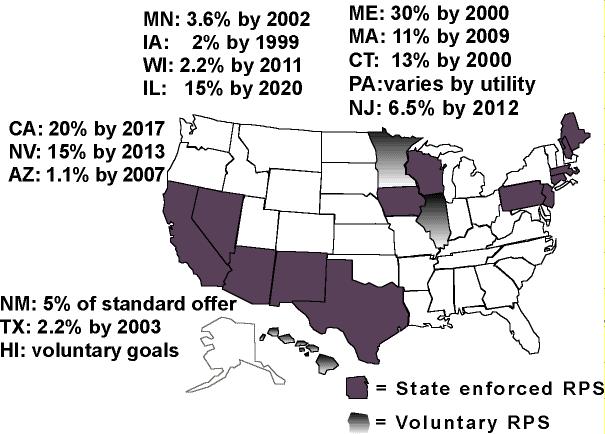| |

Policy Options:
Renewable Portfolio Standards (RPS)
Renewable Portfolio Standards (RPS) mandate a minimum
percentage of electricity be generated from renewable
sources. RPS allows flexibility to choose whichever
resources are most appropriate for their markets. (original link: CREST)
[updated link]
Renewable Energy Credits are the mechanism by which
industry buys, sells and trades electricity generated
from renewables. Credits are "tradable certificates
of proof that one kWh of electricity has been generated
by a renewable-fueled source. The RPS requires all electricity
generators or retailers to demonstrate, through ownership
of Credits, that they have supported an amount of renewable
energy generation equivalent to some percentage of their
total annual kWh sales." (original link: AWEA) [updated link]
The US's RPS is outlined below, but several other nations
also have renewable portfolio standards; Japan is targeting
3% renewable energy by 2010 and the European Union's
goal is 20% of their electricity in renewables by 2010 (orignal link:
Clean
Edge) [updated link]. According to the UNDP, a RPS can be particularly
applicable for developing nations that have a public
monopoly, but intend to reform and create a competitive
market. The RPS can be transferred to the market participants
after the reform. (China's tenth Five-Year Plan is an
example.)
To include in design of an RPS:
1. Accurate definition of renewables
2. The level of the standard must begin at, or very
near current levels of renewables and rise from that
point
3. Sunset clause: price of credit should fall to zero
when renewables are fully competitive
Benefits of RPS:
1. Ensures a minimum amount of renewable energy
for a state or country
2. Flexible- allowing industry to decide what type of
renewables to develop, where is the most cost-effective
place for the development
3. Market driven policy
United States' RPS
In the United States, most renewable
energy policy originates from state and local governments.
Over a dozen states have renewable portfolio standards
(RPS), mandating that a percentage of total electricity
purchases are derived from renewable resources.
This creates a demand for renewable electricity. Also,
it gives the suppliers the power to make decisions regarding
R&D and investment.

For specific states' policies:
(original link:(original link:Renewable
Energy Policy Project & CREST)
[updated link]
Union of Concerned Scientists: (original link: Background
of RPS) [updated link] and Analysis
of State's RPS
Resources:
:American
Wind Energy Association
(original link: Clean Energy Trends 2003) [updated link], Clean Edge
energievergelijk.nl (
https://www.energievergelijk.nl/english/renewable-energy
) |
| |
|
Email
this page to a friend
Updated: 2019/08/13
If you speak another language fluently and you liked this page, make
a contribution by translating
it! For additional translations check out FreeTranslation.com
(Voor vertaling van Engels tot Nederlands)
(For oversettelse fra Engelsk til Norsk)
(Для дополнительных
переводов проверяют
FreeTranslation.com )



